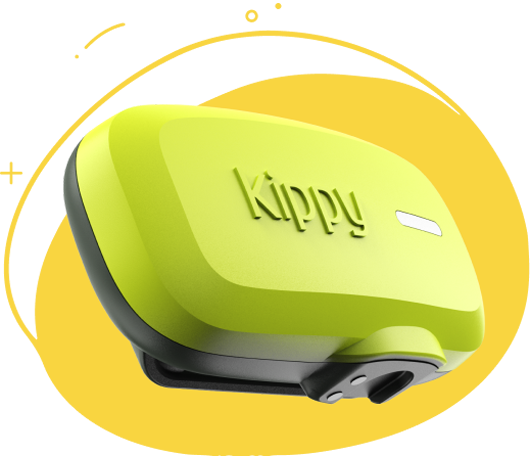
The main function of a GPS tracker for dogs, as the name suggests, is to monitor and track the real-time location of our dog, allowing us to keep them under constant supervision and find them if they run away or get lost.
If we were to make a metaphor, we could say that the GPS tracker for dogs is the best friend of man's best friend. Just like a best friend, a GPS tracker for dogs is always by our dog's side and helps us protect them.

How does
a GPS collar for dogs work?
A GPS collar for dogs primarily operates through two technologies:
- GPS with radio waves
- GPS with GSM (cellular network)
GPS tracker for dogs with radio waves
The GPS tracker for dogs with radio waves can be considered the ancestor of the category. A GPS receiver applied to the dog's collar uses signals from satellites to calculate its own position and transmits it to a portable device through radio waves.
PRO
Also locates where there is no cellular network.
As anticipated, there are GPS trackers for dogs that use the GPS + GSM technology (cellular network). Like a smartphone, these trackers can only function in areas with coverage, while those with radio waves do not require it.
Works without a subscription.
Unlike GPS trackers for dogs with GSM, which, using a cellular network, require a SIM card to function and therefore a subscription to activate it.
CONS
The price is extremely high.
Easily above €400. A GPS tracker for dogs with GSM like Kippy EVO has a much lower price instead.
Has basic functionality limited to position reception.
While a GPS tracker for dogs with GSM, using cellular networks, can provide valuable information about our pet through an app.
Localization has a very limited range.
When it comes to "GPS" trackers, it's usually believed that, given the use of satellites, the dog's location is unlimited. Nothing could be further from the truth. In fact, the receiver attached to the collar is always detectable by satellites, but its position is transmitted to the portable device through radio waves which have a limited transmission range, at most a few kilometers. This means that if our dog moves away from the coverage of the radio waves, we won't be able to locate them anymore.
GPS Tracker for Dogs with GSM
The GPS tracker for dogs with GSM is currently the most advanced technology.
Like the GPS tracker with radio waves, it has a GPS receiver that interacts with GPS satellites orbiting the Earth to calculate its own position.

The difference, however, is that the receiver's geographical coordinates are not transmitted to a device with radio waves, but to a smartphone or computer app through the cellular network.
PRO
Locates the dog's position without distance limits.
As we mentioned earlier, the GPS + radio wave tracker has very limited coverage. Additionally, cloudy skies or obstacles like buildings and vegetation can compromise reception quality. On the other hand, a satellite GPS tracker for dogs with GSM, using the cellular network, can locate your dog wherever they are. This is because it always seeks the nearest cellular network, so every time the dog is in an area with signal, they will always be traceable. Moreover, the GPS + GSM tracker also uses triangulations of cell towers and WiFi networks, so it can locate the dog even in critical GPS conditions.
Has many more features to take care of your dog.
The GPS tracker for dogs Kippy EVO, for example, has the geofence feature, which allows you to create a virtual fence around the dog and sends a notification when the fence is crossed.
Another very useful and exclusive feature on Kippy DOG is the Activity monitor. Thanks to an algorithm, Kippy DOG recognizes your friend's activities, such as walking, eating, playing, running, and sleeping, and indicates a personalized level of ideal activity to achieve.
CONS
If you live in an area with low or no cellular network coverage, then we recommend relying on a GPS tracker for dogs without a subscription (GPS with radio waves).

Best GPS for Dogs:
Without Subscription
or With Subscription?
Describing the pros and cons of the two GPS systems, the answer to the question which is the best GPS for dogs is closely related to one's own needs.
If you live in an area with low or no cellular network coverage, then we recommend relying on a GPS tracker for dogs without a subscription (GPS with radio waves).
If, on the other hand, you live in urban or suburban areas, the GPS tracker for dogs with a subscription (GPS with GSM) is the ideal choice because, in addition to providing better coverage, it offers many more services.

What are the features
of a reliable GPS tracker for dogs with a subscription?


Since the dog will have to wear the GPS tracker all day, if it were too heavy, it might bother them, and if it were too bulky, it could get caught on something, like bushes or gates, risking injury.
Among the lightest GPS devices for dogs on the market, you'll find the latest addition to the Kippy family: the Kippy DOG. It’s compact, lightweight (just 29.6 g), and durable, allowing you to track your pet everywhere, even in water! Its small size makes it suitable for all dogs, even smaller ones (from 4 kg).



As we have seen, GPS trackers for dogs with a subscription offer far more features than those without a subscription, and Kippy DOG is one of the most feature-rich options. It includes: location tracking, geofencing, activity monitoring, a flashlight and sound to better locate the dog at night, as well as a personalized messaging service providing updates on the dog's health status and tips for its well-being.


Two essential parameters to ensure a long life for a device designed to always be with your four-legged friend. Kippy DOG is 100% waterproof (IP67), resistant to dust, and can withstand immersion up to 30 minutes at a depth of 1 meter. The materials are high-quality and very durable.


The longer the battery lasts, the longer you can monitor your dog's location. An ideal battery life should be around 4 days. The battery of Kippy DOG lasts up to 15 days under optimal conditions. Duration depends on various factors such as GPS and cellular network coverage in the area and the features used.


The level of GPS and GSM network coverage (if we want a tracker with subscription) is the most important aspect to consider. Kippy DOG features GNSS satellite coverage, meaning it connects not only to GPS (American) satellites but also to Glonass (Russian) and Galileo (European), ensuring a constant satellite connection. On the GSM level, Kippy DOG covers all of Europe and requires a 4G network (or 2G fallback in its absence) to transmit location data to the smartphone app. Additionally, it automatically connects to the best available cellular network.
If Kippy DOG is too advanced for your needs, you can consider other solutions in the product range.
Other Kippy devices include Kippy EVO (the previous generation to Kippy DOG) and a collar specifically designed for cats: the Kippy CAT.
Like other Kippy devices, Kippy CAT is a collar with an integrated GPS tracker and activity monitor. It features an anti-strangulation system to prevent accidents and offers a range of useful functions to ensure your cat's well-being.
We hope this article has been helpful for you.
To learn more about the Kippy DOG GPS tracker for dogs, click here.

